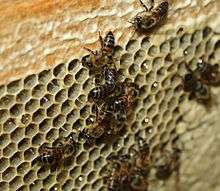Cape honey bee
| Cape honey bee | |
|---|---|
 | |
| Cape Honeybees gorging on honey. | |
| Scientific classification | |
| Kingdom: | Animalia |
| Phylum: | Arthropoda |
| Class: | Insecta |
| Order: | Hymenoptera |
| Family: | Apidae |
| Genus: | Apis |
| Species: | mellifera |
| Subspecies: | A. m. capensis |
| Trinomial name | |
| Apis mellifera capensis Eschscholtz, 1822 | |
The Cape honey bee or Cape bee (Apis mellifera capensis) is a southern South African subspecies of the Western honey bee. They play a major role in South African agriculture and the economy of the Western Cape by pollinating crops and producing honey in the Western Cape region of South Africa.
The Cape honey bee is unique among honey bee subspecies because workers can lay diploid, female eggs, by means of thelytoky, while workers of other subspecies (and, in fact, unmated females of virtually all other eusocial insects) can only lay haploid, male eggs. Not all workers are capable of thelytoky- only those expressing the thelytoky phenotype, which is controlled by a recessive allele at a single locus (workers must be homozygous at this locus to be able to reproduce by thelytoky).[1]
Interaction with African bees
In 1990 beekeepers transported Cape honey bees into northern South Africa, where they don't occur naturally. This has created a problem for the region's A. m. scutellata populations.[2] Reproducing diploid females without fertilization bypasses the eusocial insect hierarchy; an individual more related to her own offspring than to the offspring of the queen will trade in her inclusive fitness benefits for individual fitness benefits of reproducing her own young.[3]
This opens up the possibility of social parasitism: if a female worker expressing the thelytokous phenotype from a Cape honey bee colony can enter a colony of A. m. scutellata, she can potentially take over that African bee colony.[4] A behavioral consequence of the thelytoky phenotype is queen pheromonal mimicry, which means the parasitic workers can sneak their eggs in to be raised with those from the African bees, and their eggs aren't policed by the African bee workers because they're similar to the African bee queen's eggs.[5] As a result the parasitic A. m. capensis workers increase in number within a host colony, while numbers of the A. m. scutellata workers that perform foraging duties (A. m. capensis workers are greatly under-represented in the foraging force of an infected colony) dwindle, owing to competition in egg laying between A. m. capensis workers and the queen, and to the eventual death of the queen. This causes the death of the colony upon which the capensis females depended, so they will then seek out a new host colony.[6]
Conservation status
In December 2008 American foulbrood disease spread to the Cape honey bee population in the Western Cape infecting and wiping out an estimated forty percent of the region's honey bee population by 2015.[7]
Thelytokous parthenogenesis and maintenance of heterozygosity

Parthenogenesis is a natural form of reproduction in which growth and development of embryos occur without fertilisation. Thelytoky is a particular form of parthenogenesis in which the development of a female individual occurs from an unfertilized egg. Automixis is a form of thelytoky, but there are different kinds of automixis. The kind of automixis relevant here is one in which two haploid products from the same meiosis combine to form a diploid zygote.
Cape honeybee workers expressing the thelytoky phenotype can produce progeny by automictic thelytoky with central fusion (see diagram).[8] Central fusion allows heterozygosity to be largely maintained. The oocytes that undergo automixis display a greater than 10-fold reduction in the rate of crossover recombination. The low recombination rate in automictic oocytes favors maintenance of heterozygosity and the avoidance of inbreeding depression.
References
- ↑ Lattorff, H.M. G., Mortiz, R.F.A. and Fuchs, S. 2005. A single locus determines thelytokous parthenogenesis of laying honeybee workers (Apis mellifera capensis). Heredity. 94: 533-537.
- ↑ Hepburn, R. 2001. The enigmatic Cape honey bee, "Apis mellifera capensis". Bee World. 82: 181-191.
- ↑ Hamilton, W.D. 1964. Genetic evolution of social behavior I. Journal of Theoretical Biology. 7: 1.
- ↑ Hepburn, H.R. and M.H. Allsopp. Reproductive conflict between honeybees - usurpation of "Apis mellifera scutellata" colonies by "Apis mellifera capensis". South African Journal of Science. 90: 247-249.
- ↑ Wossler, T.C. 2002. Pheromone mimicry by "Apis mellifera capensis" social parasites leads to reproductive anarchy in host "Apis mellifera scutellata" colonies. Apidologie. 33: 139-163.
- ↑ Martin, S.J. Beekman, M., Wossler, T.C., Ratnieks, F.L.W. (2002) Parasitic Cape honeybee workers, Apis mellifera capensis, evade policing. Nature 415, 163-165 doi:10.1038/415163a
- ↑ Wossler, Theresa (31 July 2015). "The American disease that's wreaking havoc on South Africa's honeybee population". Quartz. Retrieved 2 August 2015.
- ↑ Baudry E, Kryger P, Allsopp M, Koeniger N, Vautrin D, Mougel F, Cornuet JM, Solignac M (2004). "Whole-genome scan in thelytokous-laying workers of the Cape honeybee (Apis mellifera capensis): central fusion, reduced recombination rates and centromere mapping using half-tetrad analysis". Genetics. 167 (1): 243–52. doi:10.1534/genetics.167.1.243. PMC 1470879
 . PMID 15166151.
. PMID 15166151.
External links
| Wikimedia Commons has media related to Apis mellifera capensis. |
- Featured Creatures Website: Cape honey bee (Apis mellifera capensis) — on the UF / IFAS website.